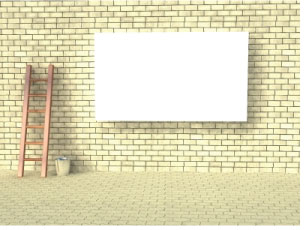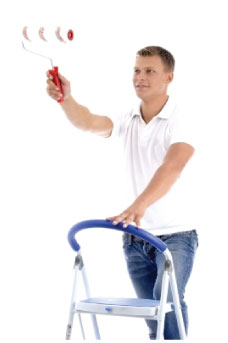Using Ladders and Stepladders Safely
Different types of ladders threaten safety in different ways. The most basic ladders used in a wide variety of working environments include single ladders, trestle ladders, extension ladders and stepladders. Let’s look at the risk associated with ladders, and how you can protect your safety while using them.
Single Ladders
A single ladder consists of two vertical bars joined by a series of horizontal rungs, with flattened “safety shoes” attached at the bottom for stability on the ground. These ladders may topple over sideways if you fail to tie off or otherwise secure them at the top. You can also create a dangerous imbalance if you step above the maximum safety level marked on the rungs, or if you have to reach out too far from the ladder to perform your work. Set the ladder up so that your body will not be too far from the wall; this may require selecting a shorter ladder than the one you’re currently using, but the extra effort could spare serious injury.
Position your ladder so you can work without reaching too far.
Extension Ladders
Extension ladders add an extra element of danger because of the multiple moving parts involved. An additional section called a fly section allows the ladder to shorten or lengthen, but this section must be firmly locked into position by rung locks. Make sure these and any other moving parts are in good condition before attempting to use an extension ladder. If your crew is setting up in a hurry, watch out for the possibility of setting the ladder upside-down by mistake (with the fly section on the bottom). The fly section lacks the safety shoes necessary for a stable foothold.
Trestle Ladders
Trestle ladders are also called “A-frame” ladders because they consist of two base sections that extend outward at an angle to each other; extension trestle ladders have centrally-mounted fly sections as well. The primary danger in trestle ladders lies in the fact that they become very unstable on anything less than perfectly even ground. Always be aware of the terrain when setting up a trestle ladder, and make sure the spreader joints are completely locked. As with single ladders, never stand on a rung higher than specified on the ladder’s warning labels.
Stepladders
Stepladders can vary from small A-frame devices that are a few feet high to full-size ladders for work at ceiling level. True to their name, these ladders offer steps on side of the base, and support rungs on the other. Never use the support rungs as steps; they are not meant to bear that kind of weight. Also, keep in mind that the top cap is not a step! In fact, you shouldn’t even stand on the top rung, because it makes the stepladder dangerously top-heavy and makes you vulnerable to toppling over.
Watch your step when using a stepladder.
All ladders should be carefully inspected before any kind of use. Any obvious flaw, such as a bent frame or spreaders that won’t lock, mean that you should retire the ladder for good. But putting a damaged ladder away is not safe enough; someone will inevitably take it out and use it by mistake. Dismantling or destroying an unusable ladder will ensure that no workers can accidentally injure themselves with it.
Wearing the proper clothing and accessories can also make on the job ladder use safer. Rubber-soled shoes can help climbers maintain solid traction with the rungs, especially in wet or dirty conditions. Products such as DuPont Tyvec Anti Skid Boot Covers can fit over regular boots if extra traction is needed. A tool belt eliminates the need to carry objects in the hands, which can interfere with your grip on the ladder’s rungs. Body harness kits such as the ConstructionPlus Roofers Kit can also help prevent falls.
Just as the right shopping cart plugins can protect online retailers and security alarms help keep office buildings safe against burglary, smart use of ladders and safety tools can prevent catastrophe in many construction, repair and maintenance applications. So take care and climb safely!
William Reynolds has worked as a freelance copywriter since 1997. William specializes in website content, ghost-blogging, print marketing content and audio/video scripts.
(Images courtesy of David Castillo Dominici and imagerymajestic /FreeDigitalPhotos.net)

